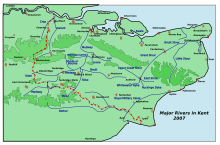River Cray
It is the prime river of outer, south-east Greater London, rising in Priory Gardens, Orpington, where rainwater percolates through the chalk bedrock of the Downs to form a pond where the eroded ground elevation gives way to impermeable clay.
It then flows by restored Loring Hall (c.1760), home of the Lord Castlereagh who killed himself there in 1822.
It neighbours a restored Gothic (architecture) cold plunge bath house, built around 1766 as part of Vale Mascal Estate.
It is then joined by the River Shuttle (a small brook) and then continues through the parkland of Hall Place, which was built for John Champneys in 1540.
Clean-ups on the (non-tidal) river and campaigns for responsible angling are organised by the Cray Anglers Conservation Group.
[1] The tidal section is effectively monitored and maintained by The Dartford and Crayford Restoration Trust,[2] who also organise Lengthsman duties for the banks.
A Domesday site,[4] Orpington Mill stood almost at the source of the River Cray.
[5] The mill building dated from the 18th century[4] and was of traditional construction, with a timber frame clad with weatherboards under a peg tile roof.
A weir near the Temple URC Church marked the site of a Domesday mill.
[4] The mill was demolished in 1872 and the area landscaped as part of the grounds of a public park.
It was used to drive a beam pump which supplied water to fountains and conservatories at "The Rookery".
This mill stood opposite the Black Boy public house; it had an undershot waterwheel.
Nicholas Townsend was mentioned in insurance records in 1757, and William Sims in 1771.
[7] In 1784 William Townsend was first mentioned as a paper maker in St Mary Cray.
[8] In 1786 Samuel Lay of Sittingbourne was the paper maker; he was described as a master papermaker in 1801.
[12] Paper produced here bore the watermarks "Joynson Superfine" or "WJ&S" over "St Mary Cray Kent".
[13] In 1839, Joynson was granted a patent for watermarking paper produced by machine.
One of them, William, drowned in 1875 leaving Edmund Hamborough Joynson as sole heir.
[7] Cowan mentions that the mill was producing an estimated 70,000 pounds (32,000 kg) of paper a week in 1878.
[7] In the late 1890s, a dryer was sold to Nash's and installed in their mill at St Pauls Cray.
[14] Edmund Joynson took his son into partnership shortly before World War One.
[17] In 1845, Mary Ann Nash inherited the profits and rents of the mill until her sons came of age under the terms of her husband's will.
In 1898 a 250 horsepower (about 190 kW) double-expansion condensing steam engine by Pollitt & Wigzell was installed, along with a second paper machine.
Shortly after this a secondhand dryer was purchased from Joynson's mill to replace one that had proved unsuitable.
In 1255, the miller, Auxellus, was censured for allowing the escape of a suspected murderer.
The miller in 1872 was Stephen Cannon (son), who concentrated the business at Bexley, the mills on the Darent being sold.
[18] A steam engine was installed in 1884, the tall chimney was built by a Mr Hart from Lancashire, who fell from the top whilst doing repairs and lived to tell the tale as his fall was broken by the roof of the engine house.
It was demolished by a traction engine in 1925, with some of the main beams being sold to an American millionaire, Mr Brady.
The waterwheel and machinery were scrapped in 1914, when roller milling plant was installed, driven by gas engines.



